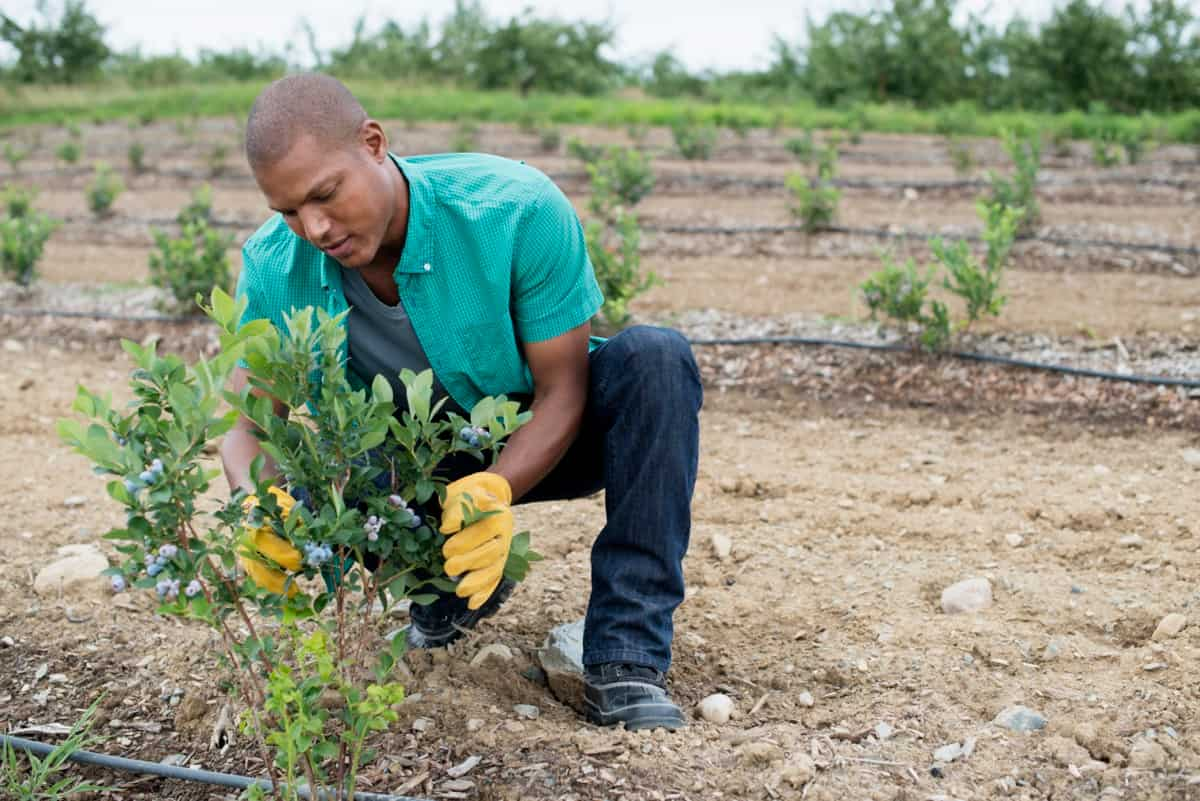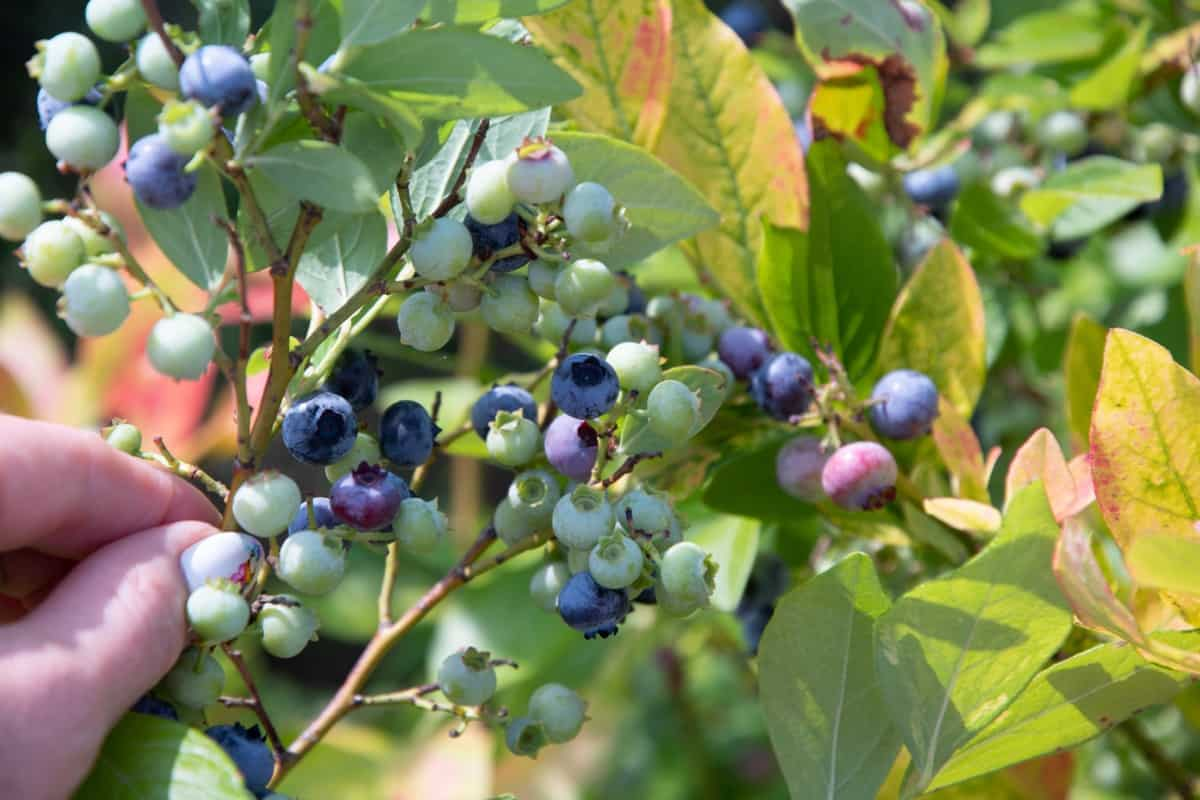Blueberries, scientifically named Vaccinium, belong to the family Ericaceae. Fertilizer is crucial in providing the necessary nutrients for these plants to thrive. To ensure healthy growth and fruit development, it is recommended to apply small amounts of fertilizer at different plant growth.

Blueberries Fertilizer Requirements and Recommendations
Best Organic Fertilizer for Blueberries
Nitrogen is essential for plant growth, and blood or fish meal can be used as organic nitrogen sources for Blueberries. These natural fertilizers provide a slow-release form of nitrogen readily available to plants. In addition to nitrogen, Blueberries require acidic soil conditions to thrive. Sphagnum peat and coffee grounds are great for adding acidity to the soil. They help lower the pH level and improve water retention, which benefits these moisture-loving plants.
Blueberry plants can become weak and susceptible to diseases without the proper nutrients and produce smaller fruit. Potassium and phosphorus are important nutrients for overall plant health and fruit development. Bone meal and powdered seaweed are excellent sources of potassium and phosphorus that can be used to fertilize Blueberries naturally. These organic fertilizers promote healthy root development, strong stems, and abundant fruit production.
Effective Fertilizer Schedule for Blueberry Plants
- Timing is key when fertilizing Blueberry plants for optimal growth and fruit development. Applying fertilizer at the right intervals is important to ensure your Blueberries thrive.
- The first fertilizer application should be done when new growth begins in the spring. This kick-starts the plant’s growth and provides the necessary nutrients to develop healthy foliage. Six weeks later, a second application should be made to support continued growth and strengthen the plant.
- When choosing a fertilizer for your Blueberries, look for one with an N-P-K ratio of about 1-1-1. This balanced ratio ensures the plant gets equal amounts of nitrogen, phosphorus, and potassium – all essential for its overall health and productivity.
Slow-Release Fertilizer for Blueberry Bushes
These are great options for Blueberry bushes as they provide a slow and steady supply of essential nutrients over a growing period. These fertilizers typically come in the form of granules or pellets that release nutrients gradually, ensuring that your Blueberry plants receive a consistent supply without the risk of over-fertilization.
It reduces the need for frequent applications. You can apply it once or twice during the growing season, saving time and effort. Additionally, slow-release fertilizers help minimize nutrient loss through leaching since they release nutrients slowly into the soil. Remember to follow the manufacturer’s instructions regarding application rates and timing. Applying too much fertilizer can lead to salt buildup in the soil, harming your Blueberry bushes.
Nitrogen Requirements for Blueberry Cultivation
- Nitrogen is an essential nutrient for Blueberry cultivation, playing an important role in the growth of these berry bushes. It promotes healthy foliage, increases fruit production, and improves plant vigor.
- To meet the nitrogen requirements of Blueberries, it is important to understand their specific needs at different stages of growth. Young Blueberry plants have lower nitrogen demands during the initial years after planting than more mature ones.
- However, as the plants mature and produce fruits, their nitrogen requirements increase significantly. This is because nitrogen is vital in forming new shoots and flower buds, eventually developing into delicious berries.
- It’s recommended to provide a balanced nitrogen supply throughout the growing season. Applying fertilizers with slow-release formulas can be particularly beneficial as they provide a steady release of nutrients over an extended period.
In case you missed it: Hydroponic Blueberry Farming in a Greenhouse: Key Rules to Start from Scratch

How to Fertilize Blueberries for Optimal Growth?
- In addition to these primary macronutrients, Blueberries also require other micronutrients such as iron and magnesium. These can be provided through specific fertilizers or supplements designed for acid-loving plants like Blueberries.
- To promote optimal growth, consider using slow-release fertilizers that gradually release nutrients over an extended period. This ensures that your Blueberry bushes receive a steady supply of nutrients without being overwhelmed by excessive amounts all at once. Remember, proper fertilizer management in Blueberries is key to achieving optimal yield.
Phosphorus and Potassium Fertilization for Blueberries
- Phosphorus promotes root development, flowering, and fruiting, while potassium enhances plant vigor and helps with disease resistance.
- When fertilizing Blueberries with these nutrients, striking the right balance is important. Too much phosphorus can lead to nutrient imbalances and environmental pollution, while insufficient potassium can result in weak plants that are more susceptible to pests and diseases.
- To ensure optimal phosphorus levels, incorporate bone meal or rock phosphate into the soil before planting your Blueberries. These organic sources slowly release phosphorus over time, ensuring a steady supply for your plants’ needs.
- Potassium fertilization can be achieved using wood ash or potash-based fertilizers. Wood ash provides an additional benefit by raising soil pH slightly – something that Blueberries prefer as they thrive in acidic conditions.
Balancing pH Levels with Fertilizer for Blueberry Crops
- Balancing the pH levels is crucial for maintaining optimal growth and productivity in Blueberry crops. Blueberry plants thrive in acidic soil with a pH range of 4.5 to 5.5, allowing them to effectively uptake essential nutrients.
- Incorporating fertilizers specifically formulated for acid-loving plants is important to achieve the desired pH level. These fertilizers provide necessary nutrients and help maintain the acidity of the soil.
- One effective approach is using sulfur-based fertilizers, such as ammonium sulfate or elemental sulfur, which can lower the soil’s pH over time. These options gradually release sulfur into the soil, helping to acidify it slowly and steadily.
- Another method uses organic materials like pine needles or sawdust as mulch around Blueberry bushes. As these materials decompose, they release organic acids that contribute to lowering the soil’s pH naturally. Regularly testing your soil’s pH levels is essential to ensure you’re providing adequate fertilizer adjustments based on its needs.
In case you missed it: How to Grow Blueberries Organically: A Step-By-Step Guide for Beginners

Preventing Nutrient Deficiencies in Blueberry Plants with Fertilizer
| Nutrient | Deficiency symptoms | Control |
| Iron | Yellowing leaves, stunted growth, and reduced fruit production | Acidify the soil, or add synthetic iron chelators |
| Phosphorus | Deficient plants may be stunted and have small leaves | Incorporating phosphorus-rich fertilizers such as bone meal or rock phosphate into the soil |
| Magnesium | Interveinal chlorosis, where the veins remain green while the areas between them turn yellow | Using fertilizers that contain magnesium sulfate (Epsom salt) or dolomitic lime |
| Potassium | Weak stems, poor fruit quality, and increased susceptibility to diseases | Fertilizing with potassium sulfate or wood ash can help maintain adequate levels of potassium in the soil |
Sustainable Fertilizer Practices for Blueberry Farming
- Before applying any fertilizers, it is essential to conduct a soil test. This will help determine the nutrient deficiencies in your soil and guide you in selecting the appropriate fertilizer blend.
- Incorporating organic matter into the soil can enhance fertility and improve nutrient retention. Consider adding compost or well-rotted manure to provide a slow-release source of nutrients.
- Planting cover crops between Blueberry rows can help increase nitrogen levels naturally by fixing atmospheric nitrogen into the soil. Legume cover crops like clover or vetch are excellent choices as they have symbiotic relationships with nitrogen-fixing bacteria.
- Applying mulch around Blueberry bushes helps conserve moisture, regulate temperature, suppress weeds, and gradually release nutrients as it decomposes. Organic materials such as pine bark or wood chips make excellent mulches for Blueberries.
- Using drip irrigation instead of overhead sprinklers ensures water reaches the root zone more efficiently while minimizing water loss through evaporation and runoff.
In case you missed it: The Best Fertilizer for Blueberries: When and How to Apply

Conclusion
Providing the right nutrients to Blueberry plants is essential for optimal yield. Blueberries thrive when given a balanced mix of nitrogen, phosphorus, potassium, and important micronutrients like iron and magnesium. Fertilizer plays an important role in the growth and development of Blueberries. These small, delicious fruits have specific nutrient requirements that must be met to ensure optimal yield.
- Feed Your Flock for Less: Top 10 Tips to Save on Chicken Feed
- Ultimate Guide to Ossabaw Island Hog: Breeding, Raising, Diet, and Care
- Hatching Answers: The Top 10 Reasons Your Chickens Aren’t Laying Eggs
- Eggs and Economics: Breaking Down the Cost of Raising Backyard Chickens
- Defend Your Greens: Proven Methods to Keep Iguanas Out of Your Garden
- Ultimate Guide to Cinnamon Queen Chicken: A Comprehensive Guide for Beginners
- Ultimate Guide to California Tan Chicken: Breeding, Raising, Diet, Egg-Production and Care
- Ultimate Guide to Marsh Daisy Chicken: Breeding, Raising, Diet, and Care
- 10 Types of Chicken Farming Businesses You Can Start for Profits